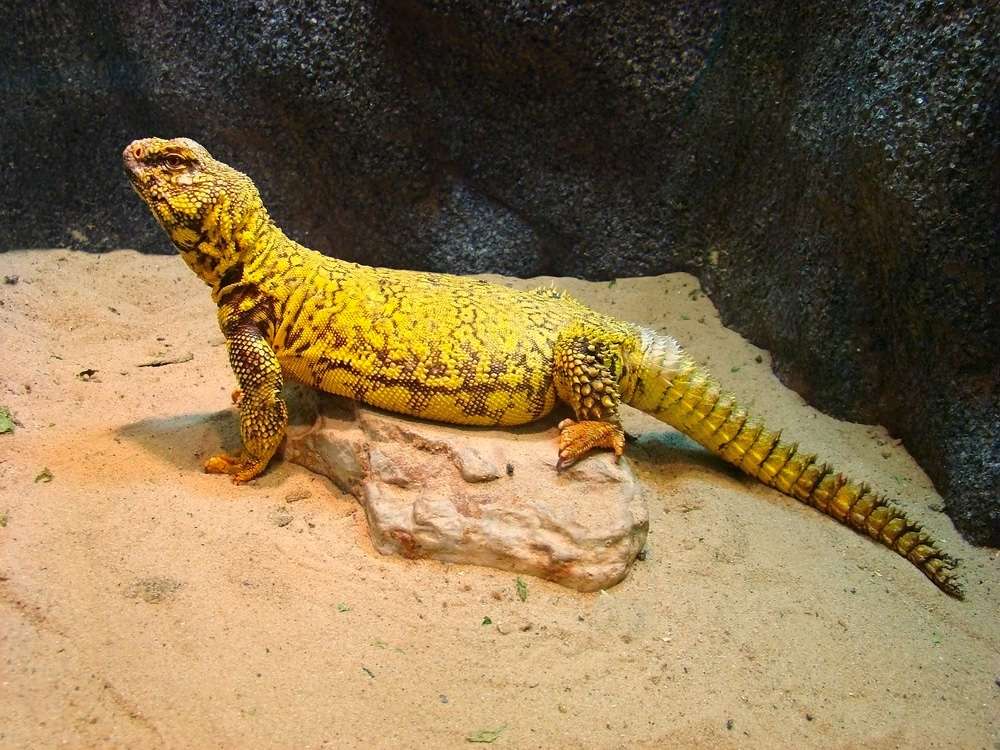
Description:
Scientific name: Uromastyx geyri
Life span: 20-25 years
For the genus, U. geyri is a tiny, slender species. Typically beige or orange in color with lighter markings, this lizard. It belongs to the Uromastyx genus’ species with the most vivid coloring. The main distinction between the “red” geyri and “yellow” geyri, U. geyri phases is their color. The yellow phase is in or close to a neon-range, and the red phase is frequently nearly solid reddish to neon pumpkin orange.
Native Region/Habitat
Algiers, Mali, and sections of Niger are home to U. geyri. In rocky, semi-arid settings, U. geyri can be found.

Behavior:
Diurnal, or daytime active, describes their behavior. To burrow, they can dig many feet down. While being terrestrial and digging frequently, they can also ascend low trees. They have a unique gland in their nose that secretes salt, which may be seen as white crusty deposits around their noses, in order to preserve water. The majority of these lizards are calm and accept handling from a pet parent.
Care As a pet/In captivity:
Habitat size:
Provide a habitat that is the right size to accommodate normal behavior and exercise. For a juvenile and an adult, the minimum habitat size is 30 and 40 gallons, respectively. As a general rule, the habitat ought to be at least four times as long as the lizard, but it’s better to offer a habitat that’s as sizable as you can. The habitats of uromastyx must have a significant temperature gradient. A tightly fitting mesh top should be present on enclosures to limit escape and for sufficient ventilation. If the weather is suitable, uromastyx can be kept outside in specially constructed habitats that are 5 to 6 feet long, 2 feet broad, and 2 feet tall for a single adult. Adults achieve their full size by the age of four.
Temperature:
Give a midday temperature gradient of 80 to 100 degrees Fahrenheit with a basking region at 110 to 120 degrees. No lower than 65°F should be allowed at night. Use at least two thermometers to keep an eye on the temperature—one in the chilly zone and the other in the basking zone. A ceramic heat bulb or an incandescent bulb can both produce heat. Thermostats should be connected to heat sources to control temperatures. Use of hot rocks as a heat source is not advised because they can burn reptiles. When kept outside of the proper temperature ranges, reptiles are more susceptible to developing an autoimmune disease.
Humidity:
Low humidity is ideal for uromastyx, which likes dry, hot environments. Keep the humidity of the habitat between 10 and 35%, with the moist dig box having a humidity of 40 to 45%. Use a humidity gauge to check the humidity levels. Lizards retain shed skin when the humidity is too low. Mist the habitat and decorations as necessary to raise the humidity. To reduce humidity, increase ventilation. Reproductively active females may drink even though most uromastyx obtain all the water they require from eating vegetables; a shallow open water bowl should be given.
Feeding:
A range of dark green, leafy vegetables is part of a well-balanced uromastyx diet. Other vegetables in smaller portions, like carrots, squash, peas, and beans, may also be served.Furthermore, millet seed and dried or sprouted lentils are favorites of uromastyx. Commercially available, soaked bearded dragon, tortoise, or iguana pellets may be fed once or twice a week, but they shouldn’t make up the majority of the diet. Once a month, insects like mealworms and crickets could be given out as a treat.
Table





